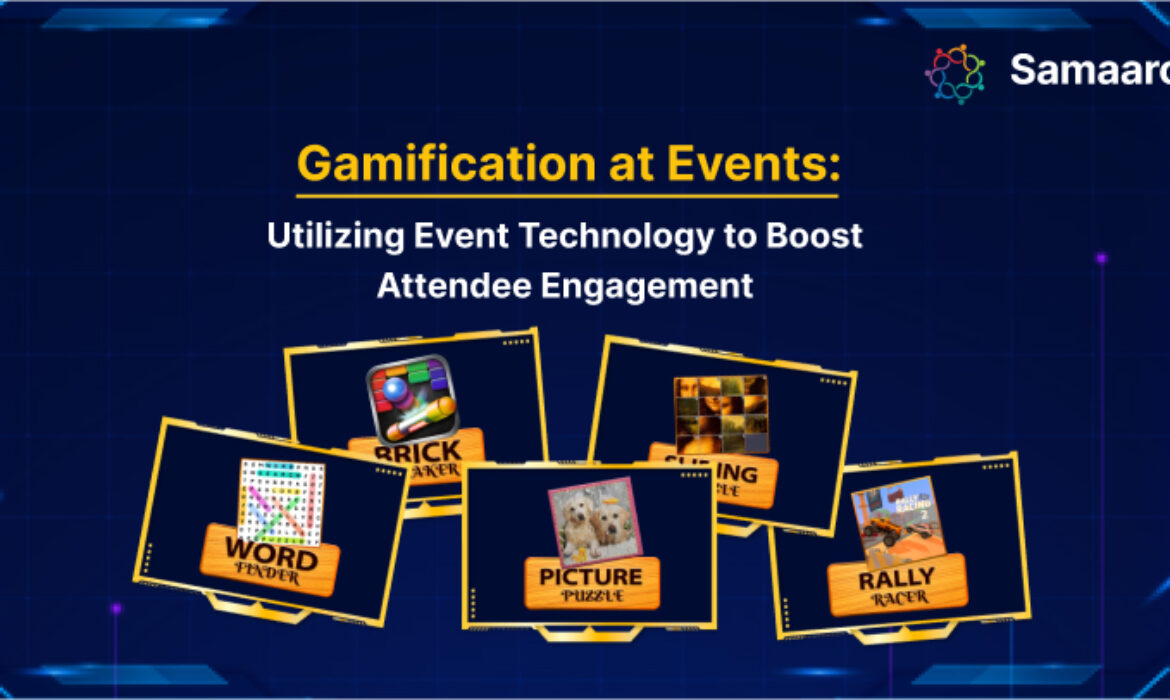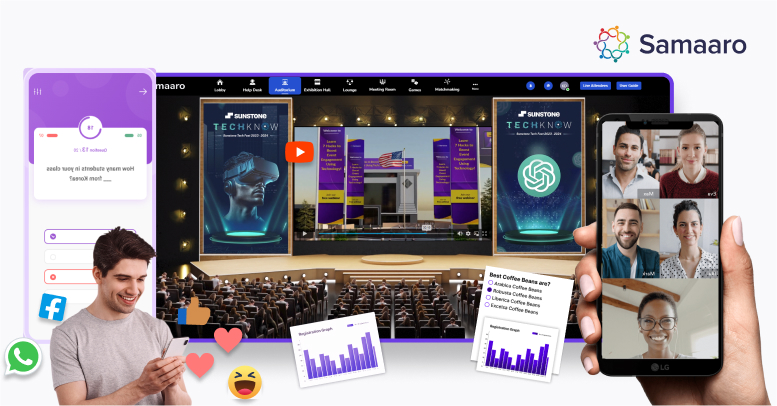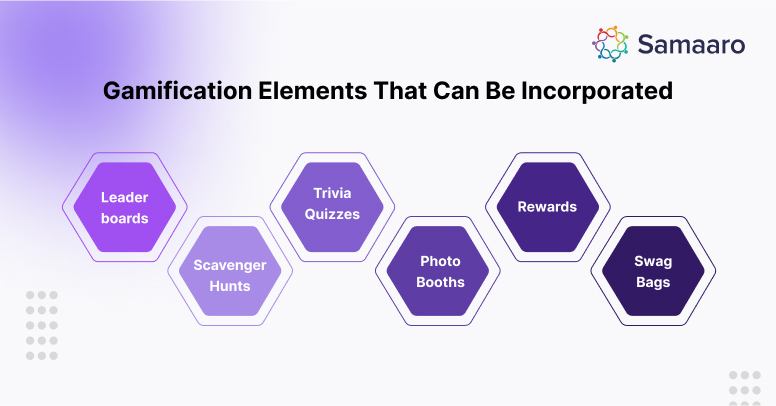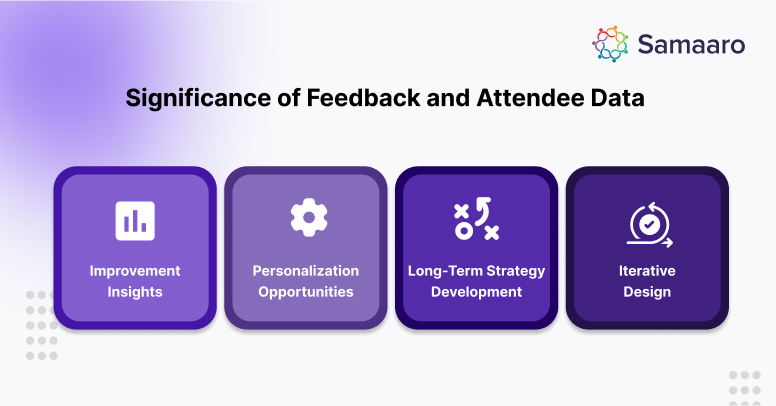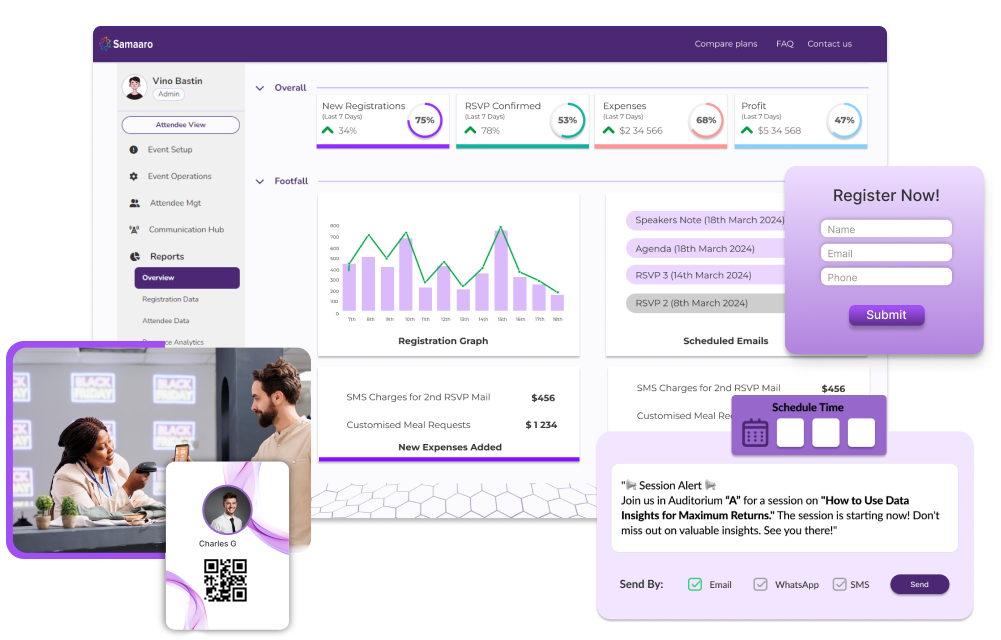When organizing events, one of the primary goals is to ensure high levels of attendee engagement. Engaged attendees are more likely to derive value from the event, actively participate in sessions, interact with fellow attendees, and provide positive feedback. This engagement not only enhances the overall event experience but also drives business outcomes such as networking, knowledge sharing, and potential partnerships.
One of the best ways of achieving attendee engagement is – Gamification. By leveraging elements such as points, badges, leaderboards, challenges, and rewards, event organizers can create immersive experiences that captivate attendees and foster active involvement. Therefore, leveraging gamification techniques through event technology can play a crucial role in boosting attendee engagement and making events more impactful. Let’s look at why gamification is important at events and some tips and tricks for incorporating and excelling at it.
The Benefits of Gamification at Event
Gamification offers advantages that reach far beyond mere attendee engagement. Its influence extends to event return on investment (ROI) and providing valuable insights for the planning of future events. Consider the following compelling rationales for harnessing the power of gamification:
Lead Generation: Gamification techniques create an engaging environment for attendees, promoting active participation in event activities such as challenges, quizzes, and scavenger hunts. This enables organizers to collect valuable attendee data, including contact information, preferences, and interests, facilitating the generation of high-quality leads.
ROI: Gamification enhances the overall attendee experience, resulting in higher satisfaction levels. This leads to positive feedback, recommendations, and potential repeat attendees, ultimately increasing ROI. Additionally, gamification provides opportunities to showcase sponsors, boost their visibility, and attract potential sponsors for future events, further improving ROI.
Sponsor Visibility: Through gamification, sponsors can create interactive experiences that boost brand exposure. They can be prominently featured in challenges, leaderboards, or branded game elements, generating awareness and recognition among attendees. Gamified sponsor activities also encourage active engagement and interaction, allowing sponsors to showcase their offerings, connect with potential customers, gather leads, and seize business opportunities.
Attendee Experience: Gamification techniques motivate attendees to actively engage with event content through goals, rewards, and friendly competition. The interactive elements of gamification not only make networking enjoyable but also foster professional relationships and a sense of camaraderie among attendees.
By leveraging gamification, event organizers can not only enhance attendee engagement but also drive lead generation, improve ROI, and provide valuable sponsor visibility. These outcomes contribute to the overall success and effectiveness of events, creating a win-win situation for organizers, attendees, and sponsors alike.
Leveraging Event Technology for Gamification
Event technology has revolutionized the way events are planned, executed, and experienced. It encompasses a wide range of digital tools and platforms that streamline event management processes and enhance attendee engagement. By integrating event technology, organizers automate gamified experiences, track progress, update leaderboards, and distribute rewards. This real-time engagement enhances attendee experience, fosters excitement, and provides valuable data for future events.
Exploring Event Technologies Suitable for Gamification
- Mobile Event Apps: Mobile event apps are a popular choice for gamification due to their versatility and accessibility. These apps can include features like challenges, quizzes, surveys, and networking functionalities. Attendees can easily access and participate in gamified activities through their smartphones, receiving instant updates and notifications.
- Event Technology Platform: Event platforms offer a range of features suitable for gamification. These platforms can host virtual games, interactive sessions, and provide personalized dashboards for attendees to track their progress. They often integrate with social media platforms and enable participants to share achievements and engage with each other.
- QR Codes: Quick Response (QR) codes have become increasingly popular in gamification at events. Attendees can scan QR codes placed strategically throughout the event venue to access gamified content, such as clues, challenges, or bonus points. QR codes can also be used to facilitate networking by allowing attendees to exchange contact information digitally or participate in interactive activities.
Now, once you have event technology for gamification, it is crucial to utilize it, which will effectively engage the audience. By leveraging the capabilities of event technology, you can design interactive and immersive game experiences that captivate and involve attendees. Let’s talk about some strategies for gamification in events.
Gamification Strategies for Events
To effectively incorporate gamification into in-person events, it is crucial to establish clear objectives and goals. This involves determining what you want to achieve through gamification and how it aligns with the overall event objectives. For example, you might aim to increase attendee engagement, enhance networking opportunities, or encourage participation in sessions and activities. Let’s take a look at some Game Mechanics that you can incorporate in your event.
Designing Game Mechanics and Elements for Engagement
To make gamification engaging and enjoyable, it is important to design effective game mechanics and elements. Here are some examples:
- Points, Badges, and Leaderboards: Implement a points-based system where attendees earn points for completing specific actions or achieving certain milestones. Badges can be awarded for completing challenges or reaching specific levels. Leaderboards can display the top performers, creating a sense of competition and motivation.
- Scavenger Hunts: Organize scavenger hunts that encourage attendees to explore the event venue or interact with exhibitor booths to find hidden clues or objects. This promotes active participation and discovery.
- Challenges and Competitions: Introduce challenges and competitions that attendees can participate in, such as photo contests or trivia quizzes. Encourage friendly competition among attendees and provide rewards or recognition for winners.
- Rewards and Incentives: Offer rewards and incentives to motivate attendees to actively engage in gamified activities. These could include exclusive access to special sessions, VIP perks, or merchandise.
Merely incorporating these elements is insufficient; utilizing them strategically in the appropriate areas will give you a competitive advantage in engaging audiences and generating leads.
Creative Strategies for Integrating Gamification into Different Aspects of Event Planning
Gamification can be integrated into various aspects of event planning to enhance the attendee experience. Consider the following strategies:
- Registration: Gamify the registration process by offering incentives or early-bird rewards for completing registration early or referring friends to attend.
- Sessions: Introduce interactive elements within sessions, such as live polling, quizzes, or challenges that attendees can participate in using their mobile devices. This fosters engagement and active learning.
- Networking: Encourage networking by incorporating gamified icebreaker activities or matchmaking features within the event app. Attendees can earn points or badges for connecting with new people or participating in networking activities.
- Exhibitor Interactions: Gamify exhibitor interactions by implementing challenges or tasks that attendees can complete at different booths. Offer rewards for visiting a certain number of booths or engaging in specific activities, such as product demonstrations or scavenger hunt tasks.
By incorporating gamification strategies into events, you can create an immersive and engaging experience that encourages attendee participation, fosters connections, and enhances overall event satisfaction.
Measuring the Success of Gamification
To determine the impact and effectiveness of gamification strategies, it is important to explore relevant metrics and utilize appropriate tools. Consider the following approaches:
- Engagement Metrics: Measure attendee participation, such as the number of challenges completed, points earned, or badges obtained. This data indicates the level of engagement with gamified activities.
- Feedback Surveys: Collect feedback from attendees about their experience with the gamification elements. Ask specific questions regarding the enjoyment, motivation, and perceived value of the game mechanics.
- Social Media Monitoring: Monitor social media platforms to assess the level of buzz and conversations generated by the gamification aspects. Look for mentions, hashtags, and user-generated content related to the games.
- Analytics and Tracking: Utilize event technology platforms or dedicated analytics tools to track attendee behavior and interactions within the gamified environment. Analyze data such as session attendance, time spent on specific activities, or completion rates.
Conclusion
In conclusion, event organizers should embrace gamification as a powerful tool for creating memorable and interactive experiences at events. By leveraging event technology and designing effective game mechanics, organizers can foster engagement, enhance networking opportunities, and drive positive outcomes. With continuous evaluation, refinement, and utilization of attendee feedback and data, gamification can unlock the full potential of events, delivering valuable experiences that leave a lasting impact on attendees. For an event experience that delivers results, using an event technology is crucial, contact Samaaro today to explore how our event technology solutions can empower your gamification efforts and transform your next event into an immersive and engaging experience.

